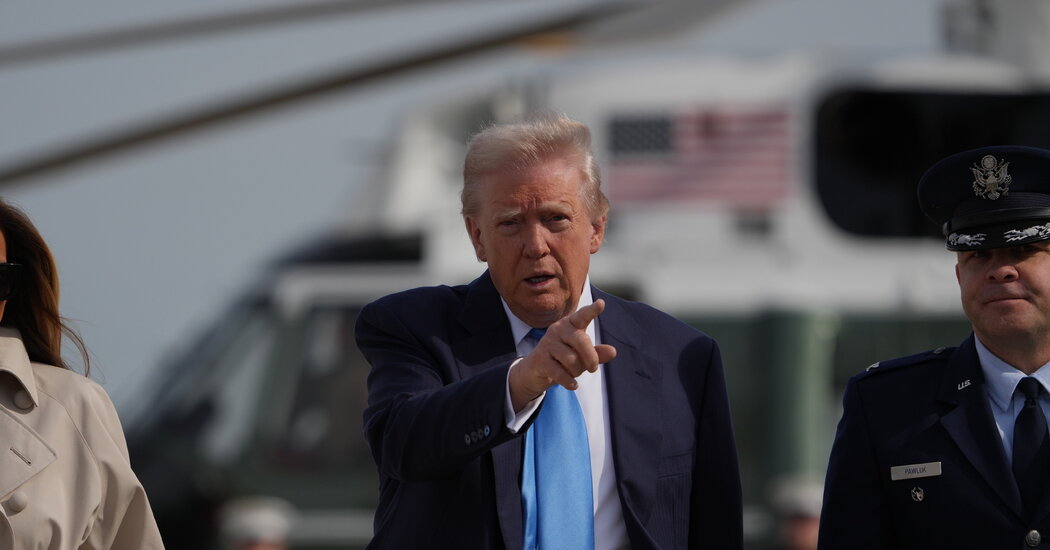President Trump is approaching the 100-day mark of his second term with historically low levels of support and growing questions from voters about his use of power to advance his agenda, according to the latest poll from The New York Times and Siena College.
His approval rating is 42 percent, low for a president who just took office, and he shows early signs of erosion on a signature strength: the economy.
Mr. Trump’s base of Republican support remains resilient and solidly behind him. But he faces united opposition from Democratic voters and skepticism from independent ones.
Here are five takeaways:
Voters think Trump has ‘gone too far.’
Perhaps the most notable finding from the poll is that voters see Mr. Trump as overreaching in his first three months.
Over and over, voters said he had “gone too far.” Looking at all the ways he has changed the nation’s political and economic systems, 54 percent said he had “gone too far” — twice as many as said he had been “about right.”
But voters also applied that label on several policies that he has tried to sell, including tariffs, immigration enforcement and cuts to the federal work force. Majorities of voters agreed that Mr. Trump had gone too far on all three issues.
And overall, more voters said he was “exceeding his powers” than those who thought he was simply exercising presidential authority.
Trump is seen as more ‘scary’ and ‘chaotic’ than ‘exciting.’
The poll showed that far more voters believed the words “scary” and “chaotic” captured the early stages of the second Trump presidency than those who thought “exciting” did.
Two-thirds of voters, including 75 percent of independent voters, said that “chaotic” was a good description of the Trump term so far. But chaos has not always been a bad thing for Mr. Trump, and nearly half of Republicans embraced the label, too.
It is safe to say that Democrats do not find the upheaval “exciting”: Only 10 percent used that label, compared with 82 percent of Republicans. Crucially, just 34 percent of independent voters said the change had been “exciting,” far fewer than the 61 percent who called it “scary.”
Trump’s agenda isn’t selling — yet.
The poll asked voters whether they approved of Mr. Trump’s approach in seven policy areas. Majorities disapproved of his handling of all seven.
The list included immigration, trade with other countries, foreign conflicts and managing the federal government.
One of the poll’s few bright spots for Mr. Trump is that a majority of Americans still favor deportations of people living in the United States illegally. But they expressed skepticism of some of his specific actions, like deporting legal immigrants who have protested Israel or threatening to send American citizens to prison in El Salvador.
The poll also asked about specific policies that Mr. Trump has pursued, including ending diversity, equity and inclusion programs and withholding federal money from some universities. Half or more voters opposed both moves.
Trump is losing his advantage on the economy.
For years, one of Mr. Trump’s political assets — perhaps a relic from his years hosting “The Apprentice” — has been the widespread view that he is a businessman who knows what he is doing when it comes to the economy.
Not in this poll. Mr. Trump’s approval rating on the economy was only 43 percent. Just as worrisome for him: Voters don’t seem to think he understands their problems.
The economy was one of the biggest factors in Mr. Trump’s victory last year. He promised over and over to tackle inflation on Day 1. But voters aren’t feeling any relief yet. Quite the opposite: More than twice as many said the economy was doing worse since he took office than better.
Voters don’t like Elon Musk.
Mr. Trump’s approval rating is low, but Elon Musk’s is lower.
Mr. Musk, the world’s richest man and a top presidential adviser, was viewed favorably by only 35 percent of voters. Skeptical views of him were consistent among men and women, the young and the old, across all races and levels of education.
The Times/Siena poll even ran a small experiment to test Mr. Musk’s unpopularity. It asked respondents twice about their views of the cuts by the Department of Government Efficiency, using Mr. Musk’s name once and leaving it out the other time.
The cuts were more popular when voters didn’t hear the word “Musk.”
Shane Goldmacher is a Times national political correspondent.
The post Five Takeaways From the Times/Siena Poll appeared first on New York Times.




